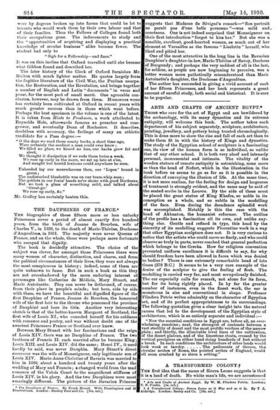ARTS AND CRAFTS OF ANCIENT EGYPT.* THOSE who care for
the art of Egypt and are bewildered by the archaeology, with its many dynasties and its extreme antiquity, will welcome this book. The author takes each department of his subject separately, sculpture, architecture, painting, jewellery, and pottery being treated chronologically.
This is done more to show the rise and fall of each art than to make them fit in with the history of Kings and dynasties.
The study of the Egyptian school of sculpture is a fascinating one, its view of the human form is so individual, so unlike that of any other school. It is both very aloof and intensely personal, monumental and intimate. The vitality of the wooden statues of remote antiquity is astonishing, none more so than the head of Nofert, which in the illustration in the book before us seems to go as far as it is possible in the direction of conveying the illusion of life. At the same time, it is not mere realism, for the feeling for design and largeness of treatment is strongly evident, and the same may be said of the seated scribe in the Louvre. By the side of these must be placed the great statue of King Khafra, so noble in its conception as a whole, and so subtle in the modelling of the face. Even during the decadence splendid work was accomplished. Notably is this the case with the head of Akhnaton, the humanist reformer. The outline of the profile has a fascination all its own, and unlike any.
thing else. Gentle and refined in type, this head by the sincerity of its modelling suggests Florentine work in a way that other Egyptian sculpture does not. It is very curious to notice that the artists who could carve so finely, and who could observe so truly in parts, never reached that general perfection which belongs to the Greeks. How far religious convention prevented uniform excellence it is difficult to say, for why should freedom have been allowed in faces which was denied to bodies P There is one extremely remarkable head of late times (378 B.C.) It seems to be a very rare example of the desire of the sculptor to give the feeling of flesh. The modelling is carried very far, and most scrupulously finished. The ear especially calls for remark, not alone for its form, but for its being rightly placed. In by far the greater number of instances, even in the finest work, the ear is monstrous in size and conventional in shape. Professor Flinders Petrie writes admirably on the character of Egyptian art, and of its perfect appropriateness to its surroundings. The following quotation gives a clear insight into the natural causes that led to the development of the Egyptian style of architecture, which is so entirely separate and individual
"Now the essential conditions in Egypt are, before all, an over- whelming sunshine ; next, the strongest of contrasts between a vast sterility of desert and the most prolific verdure of the narrow plain ; and thirdly, the illimitable level lines of the cultivation, of the desert plateau, and of the limestone strata, crossed by the vertical precipices on either hand rising hundreds of feet without a break. In such conditions the architecture of other lands would look weak or tawdry The pediments of Greece, the circular arches of Rome, the pointed arches of England, would all seem crushed by so stern a setting."






































 Previous page
Previous page